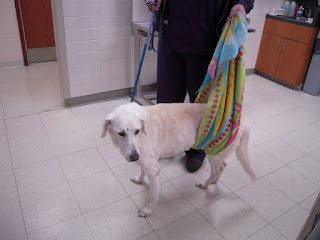Did your family get a new pet this holiday season? Here are some tips to make the transition smoother for everyone:
- Be prepared! Make sure you have everything your new pet will need before they arrive. For dogs this means food, dishes for food and water, a leash and collar with an ID tag, toys, and a crate (if you will be using one). Cats will also need food, dishes, and toys, as well as a carrier. Indoor cats don't need a collar, but some people have their indoor cats wear one, just in case they sneak outside.
- Make it feel like home. If possible get a small amount of food, some toys, or a blanket from the pet's previous home. The food will allow you to switch gradually to the new diet, which will help prevent gastrointestinal upset. The toys and blanket will have familiar smells, and will help your new pet feel more comfortable.
- Prepare the welcoming committee. Try to bring your new pet home on a weekend, or when you have a few days off so you can get to know each other. Make sure everyone in the house knows all of the rules and who is responsible for each new duty. For example, if your new pet is not allowed on furniture, everyone in the house should be aware of that. If you already have other pets in the house, prepare to introduce them to their new family member gradually.
- Meet the vet. Even if your new pet is up to date on all vaccines and blood tests, it's a good idea to bring them to a veterinarian for a check up within the first week. Be sure that any pets already living at home are relatively healthy and fully vaccinated before you bring the new pet home. If the new pet has not been spayed or neutered, be sure to make that appointment as soon as possible.









































 Not only can fleas make your pet itchy and cause anemia, but they can carry diseases like Bartonella (also known as "cat scratch disease"), and parasites such as tapeworms. Ticks harbor many diseases as well, including Lyme disease and Rocky Mountain Spotted Fever.
Not only can fleas make your pet itchy and cause anemia, but they can carry diseases like Bartonella (also known as "cat scratch disease"), and parasites such as tapeworms. Ticks harbor many diseases as well, including Lyme disease and Rocky Mountain Spotted Fever. 

